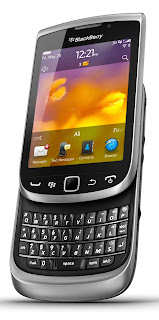The 3.2-inch display on the Torch 9810 is very attractive. It boasts a 640x480-pixel resolution, and OS 7 promises a new Liquid Graphics technology that RIM says allows for improved graphics and a more responsive touch screen. Graphics and text look smooth, sharp, and crisp thanks to the improved pixel density. We experienced zero lag when navigating the phone and launching applications, perhaps thanks to the phone's 1.2GHz Qualcomm Snapdragon processor as well. For simple navigation, we thought it was on par with Android smartphones with dual-core processors.
The Torch 9810 has a proximity sensor and supports pinch-to-zoom gestures. Located right underneath the display are the Send, Menu, Back, and End/Power keys with BlackBerry's traditional optical touch pad in the middle. While it might seem redundant to have both a touch screen and the optical touch pad, the touch pad allows for finer and more precise control in certain applications. Still, we found that the touch screen alone worked well enough most of the time.
If you want to type up a quick text, you can choose to use the onscreen keyboard. It works both in portrait and landscape mode, and is surprisingly spacious, with large keys and sufficient room between each key. Our only complaint is that the screen's smaller-than-usual size reduces the text input area significantly when the onscreen keyboard is on display. The OS 7 keyboard boasts improved text prediction, and indeed, perhaps because of our proclivity toward onscreen keyboards, we actually found it faster and easier than the physical version.
But if you insist on using the latter, fear not, as the Torch 9810 slides open vertically to reveal that famous BlackBerry QWERTY keyboard. The slider mechanism is smooth, solid, and springs securely into place in either the open or closed position. As we mentioned earlier, this is the same form factor as on the original Torch 9800. Yet, the keyboard is just a touch wider on the 9810, and it's not quite as thin as before. We still think large thumbs might need some time to acclimate to it, but on the whole, we found typing to be quite comfortable. The keyboard is roomy enough for a portrait slider, and though the keys are small, they're raised so it's still easy to text by feel.
The rest of the phone's external controls mirror those of the Torch 9800. You get the lock and mute buttons at the top of the phone, the Micro-USB port on the left spine, and the 3.5mm headset jack, volume rocker, and customizable convenience key on the right. The camera lens and LED flash are on the back, while the microSD card slot is located behind the battery cover. AT&T packages the Torch 9810 with an AC adapter, a USB cable, a wired stereo headset, a polishing cloth, and reference material. For more add-ons, please check our cell phone accessories, ringtones, and help page.
Features
One of the key features of the Torch 9810 is that it ships with BlackBerry OS 7. The user interface is the same as OS 6, with the Quick Access area, notification bar, and navigation bar with multiple menu screens. You can collapse and expand each area, and swipe and left to switch categories. Aside from the Liquid Graphics technology we mentioned earlier, OS 7 also adds a voice function to universal search, a revamped BlackBerry browser with HTML 5 video support, 720p HD video recording, and support for augmented reality apps. OS 7 also supports NFC, but the Torch 9810 does not have that. For more on the browser, check out our review of the Torch 9810 for AT&T.
The rest of the phone's features are to be expected on a BlackBerry. It has Bluetooth, Wi-Fi, GPS, a speakerphone, voice-activated dialing, smart dialing, conference calling, speed dial, visual voice mail, and text and multimedia messaging. You can combine all the messaging systems into a single universal inbox if you like, and it supports threaded conversations and group chat.
BlackBerry's strength has always been its strong e-mail integration and it's no different with the Torch 9810. It's able to sync with BlackBerry Enterprise Server as well as Microsoft Exchange, IBM Lotus Domino, and Novell GroupWise for all your corporate e-mail needs. You can also use a free but limited version of BES that lets you sync your Exchange calendar, contacts, and tasks. If you want to check your personal e-mail, the Torch 9810 lets you access up to 10 personal/business POP3 or IMAP4 e-mail accounts in either separate or combined in-boxes via BlackBerry Internet Service. There's a handy setup wizard that walks you through the process of setting up your BlackBerry ID and connecting that to your e-mail address.
If you use a web mail service like GMail, Yahoo, AOL, or Windows Live, it's as easy as entering in your login information--you can also set up your own POP3 and IMAP4 account if you wish. We were able to get our Gmail account added in just a few steps, but it did take almost 20 minutes for the phone to sync up our inbox.








+1.jpg)



0 komentar:
Posting Komentar